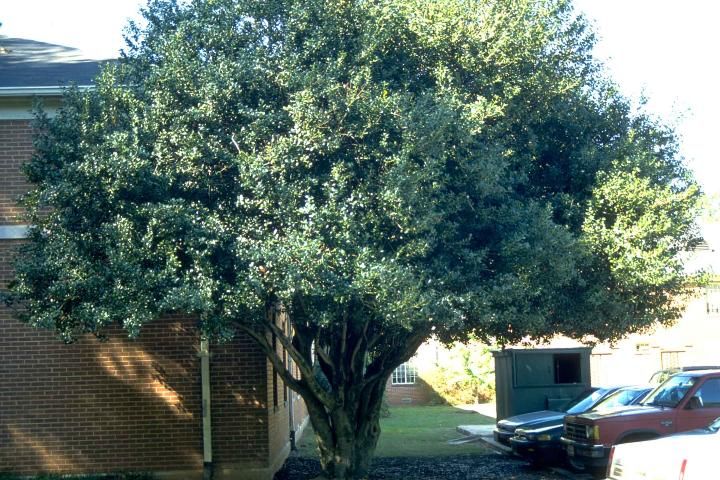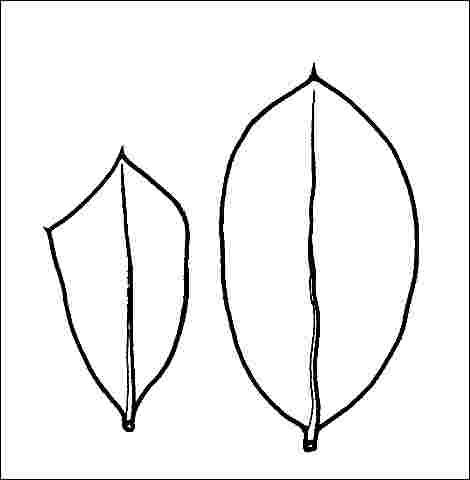Ilex cornuta 'Burfordii': Burford Holly1
Introduction
This dense evergreen shrub or small tree has glossy, dark green leaves, each with a single terminal spine. Leaves are among the glassiest and darkest green of trees. The somewhat-showy clusters of fragrant, springtime, white flowers attract bees. The large, bright red, long-lasting berries during the fall and winter provide a nice contrast to the dark green leaves. The plants are self-fertile and do not need a male plant located nearby for pollination. It is one of the most popular shrubs in some areas of the country.

Credit: Ed Gilman
General Information
Scientific name: Ilex cornuta
Pronunciation: EYE-lecks kor-NOO-tuh
Common name(s): Burford Holly
Family: Aquifoliaceae
USDA hardiness zones: 7A through 9B (Fig. 2)
Origin: not native to North America
Invasive potential:has been evaluated using the IFAS Assessment of the Status of Non-Native Plants in Florida's Natural Areas (UF/IFAS 2018). This species is not documented in any undisturbed natural areas in Florida. Thus, it is not considered a problem species and may be used in Florida.
Uses: sidewalk cutout (tree pit); parking lot island < 100 sq ft; parking lot island 100-200 sq ft; parking lot island > 200 sq ft; tree lawn 3-4 feet wide; tree lawn 4-6 feet wide; tree lawn > 6 ft wide; street without sidewalk; deck or patio; screen; espalier; urban tolerant; highway median; container or planter; hedge
Availability: not native to North America

Description
Height: 15 to 25 feet
Spread: 15 to 25 feet
Crown uniformity: symmetrical
Crown shape: vase, round
Crown density: dense
Growth rate: moderate
Texture: medium
Foliage
Leaf arrangement: alternate (Fig. 3)
Leaf type: simple
Leaf margin: entire, terminal spine
Leaf shape: oblong, elliptic (oval)
Leaf venation: pinnate
Leaf type and persistence: evergreen
Leaf blade length: 2 to 4 inches
Leaf color: green
Fall color: no color change
Fall characteristic: not showy

Flower
Flower color: white/cream/gray
Flower characteristics: not showy
Fruit
Fruit shape: round
Fruit length: less than .5 inch
Fruit covering: fleshy
Fruit color: red
Fruit characteristics: attracts birds; showy; fruit/leaves not a litter problem
Trunk and Branches
Trunk/bark/branches: branches droop; not showy; typically multi-trunked; thorns
Pruning requirement: little required
Breakage: resistant
Current year twig color: green, gray
Current year twig thickness: medium
Wood specific gravity: unknown
Culture
Light requirement: full sun, partial sun or partial shade
Soil tolerances: clay; sand; loam; alkaline; acidic; extended flooding; well-drained
Drought tolerance: high
Aerosol salt tolerance: moderate
Other
Roots: not a problem
Winter interest: yes
Outstanding tree: no
Ozone sensitivity: unknown
Verticillium wilt susceptibility: resistant
Pest resistance: resistant to pests/diseases
Use and Management
Although typically pruned for formal hedges, the large form and gracefully drooping branches of Burford Holly make it ideal for unpruned natural plantings or as a specimen for spacious areas and large buildings. There are much better plants for pruning into formal hedges. Burford Holly can also be trained as an attractive vase-shaped multi-stemmed small tree. Trees trained in this fashion often have a thick crown comprised of many branches and small-diameter trunks. Burford Holly should be grown and used in this fashion more often.
Growing best in rich, well-drained, slightly acid soil, Burford Holly does well in full sun or part shade. However, flowering and subsequent fruiting is reduced in shady locations. Burford Holly is drought-tolerant and easy to grow once established. It is well suited for low-maintenance landscapes which receive little or no irrigation or fertilizer after trees are established. Once the tree reaches 10 or 15 feet tall, growth rate slows. `Burfordii Nana' makes a better shrub than `Burfordii' due to a slower growth rate and smaller leaves.
Propagation is by cuttings only.
Pests
Burford Holly can be plagued with severe infestations of tea scale.
Diseases
No diseases are of major concern.
Literature Cited
University of Florida, Institute of Food and Agricultural Sciences. 2018. "Assessment of Non-native Plants in Florida's Natural Areas" (https://assessment.ifas.ufl.edu, 4/29/2019) Gainesville, FL, 32611-4000, USA.


